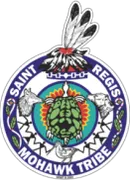On Monday, July 8, Judge Lawrence E. Kahn, issued an Order accepting the majority of the recommendations made by Magistrate Judge Dancks in September, 2012. Judge Kahn accepted the arguments of the Mohawk plaintiffs that the 2,000 acres, known as the Hogansburg Triangle, and located in the middle of the reservation, remains part of the Saint Regis Mohawk Reservation reserved by Treaty in 1796. Not surprisingly, the Court dismissed claims to the remaining areas identified in the Tribe’s Treaty of 1796, citing laches, the defense used by the State and Counties in other claims that have been dismissed in New York. “Laches” is considered an equitable defense, which is intended to look at fairness and disruption to current owners of land claimed by Indian tribes.
In reaching his decision, Judge
Kahn cited specific factual differences between the Mohawk claims and the
claims of other Nations in New York, previously dismissed by federal
courts. Using census data, showing
Mohawk ownership and presence in the claim areas, he concluded that the
Hogansburg Triangle “does not have a clearly ‘non-Indian’ character” so that
settled expectations would “be upset by an ultimate judgment in [the Mohawks]
favor.” Based on that conclusion, the
Court will allow the Mohawks to continue pursuing their legal claims, as to the
areas identified by the Court.
As for the claim for Barnhart, Croil and Long Sault Islands, the United States and the Mohawks have presented a unique argument that has never been considered in any other land claim because of the particular facts of the case, which indicate a Federal, rather than State original ownership of the lands. “We are disappointed that Judge Kahn dismissed the Tribe and the United States’ arguments with regard to the Island Claims. He applied the defense of laches, without fully addressing the ownership and occupation of the Islands—where very little disruption would occur had the court allowed the claims to remain,” stated Chief Ron Lafrance, Jr., “Although we feel vindicated with regard to the claims to the original reservation, short of a negotiated settlement of the Mohawk claims, this 32 year old legal battle is far from over.” Appeals could take years to resolve.
The Mohawks have stated their continued desire to resolve this decades-old land dispute with the State of New York and the surrounding counties and towns. “We continue to believe that it would be in the best interest of all parties to resolve this case through settlement, rather than continuing to engage in this costly and protracted litigation. Resolution would bring clarity and as well as financial benefits to the local governments and surrounding communities,” stated Chief Paul Thompson.
Although the land claims litigation is important to the Mohawk plaintiffs, they have stated that a legal loss will not change the make-up of the lands at issue and will not resolve the longstanding disputes between the parties. In addition to the Land Claim litigation at issue here, the Mohawks, the State and Counties could continue to litigate land issues indefinitely, as there are also separate land-into-trust litigation and a boundary claim, which requests that the Courts recognize the original boundaries of the reservation.
“The Mohawks, and I’m sure the counties and towns, have spent millions of dollars litigating these claims, and it is time to come together and resolve the matter among those most affected, the Mohawks and our neighbors and partners.” said Chief Ron LaFrance.
In 2005, as part of lengthy negotiations between the Tribe, the State and the Counties, a settlement was reached that would allow the Mohawks to purchase, from willing sellers within their original reservation, parcels that would then be recognized as part of the reservation. This settlement was part of larger negotiations, which included revenue sharing provisions, from the Tribe’s Akwesasne Mohawk Casino. “The Counties and towns have benefited from the revenue sharing provisions negotiated in exchange for settlement, but have, as yet, refused to implement the 2005 Agreement. We believe that with the assistance and support of Governor Andrew Cuomo, we are closer than ever before to reaching accord with the Counties and towns,” said Chief Paul Thompson, who was part of the Tribal negotiation team leading up to the 2005 land claim and revenue sharing agreements.
As part of an agreement over the Tribe’s revenue sharing dispute with New York State reached in May, Governor Cuomo brought all of the parties back to the table, including the affected towns, in what have been positive discussions to date. “The Saint Regis Mohawk Tribe believes that the Governor will honor his commitment to see a negotiated resolution of our land claims. This decision does not change the fact that negotiated settlement remains in all parties best interests.” said Chief Paul Thompson, “We would prefer to expend our resources on economic development that benefits the North Country, than to continue litigation, that at the end of the day, benefits no one.”
“We would prefer a negotiated
settlement to taking lands-into-trust.
The land-into-trust process is expensive and time consuming, and, while
it remains an option to the Tribe, would result in lands being taken, without
agreement of the local governments—we understand that this will only continue
the disputes over land that we’ve all endured for hundreds of years,” said
Chief Ron Lafrance.
# # # #
Contact the Public Information Office at 518-358-2272 for media inquiries.

